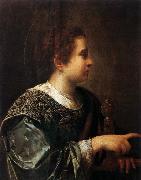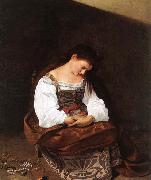El Petróleo al por mayor de China que no Pinta Mínimo |
|
|||||||||||||||||||
|
|
|||||||||||||||||||
|
1660-70 Galleria degli Uffizi, Florencia 1660-70 Galleria degli Uffizi, Florence |
|||||||||||||||||||
|
|
|||||||||||||||||||
|
|
|||||||||||||||||||
|
| 1614-15 Oil on panel, 63 x 49 cm | ||||||||||||||||||
|
|
|||||||||||||||||||
|
|
|||||||||||||||||||
|
| 122,5 x 98,5 cm Galleria Doria-Pamphili, Rome This picture and The Rest on the Flight into Egypt must have been painted around the same time, for the same girl sat for the Magdalene and the Madonna. On this occasion, however, there are none of the usual signs of a religious scene such as a halo. A young girl, seen from above, is seated on a low stool in one of Caravaggio's favourite cave-like settings, with a triangle of light high up on the wall behind her. Discarded jewellery - a string of pearls, clasps, a jar (perhaps holding precious ointment) - lies on the floor. The girl's hair is loose, as if it has just been washed. Her costume, consisting of a white-sleeved blouse, a yellow tunic and a flowery skirt, is rich. Bellori, who gives a careful description of this picture, which he came across in the collection of Prince Pamphilj, regards its title as an excuse; for him it is just a naturalistic portrayal of a pretty girl. This seems to show a willful failure to understand Caravaggio's intention or the wishes of the man who commissioned it, Monsignor Petrignani. The repentant Mary Magdalene, like the repentant Peter, was a favourite subject of Counter-Reformation art and poetry, which valued the visible expression of the state of contrition 'the gift of tears'. Caravaggio's heroine is sobbing silently to herself and a single tear falls down her cheek. She is, as it were, poised between her past life of luxury and the simple life she will embrace as one of Christ's most faithful followers. It is a sign of the painter's skill that he makes this inner conflict moving at the same time as he makes its representation delectable. Although nothing painted in the sixteenth century is as emotive as the statue in wood of the haggard saint carved by Donatello (c.1456-60), by the time Titian's bare-breasted Magdalene of the 1530s (Palazzo Pitti, Florence) had become the more modest and affecting Magdalene of the 1560s, there had been a move in religious sensibility towards the humble and pathetic, a change which thirty years later Caravaggio could take for granted | ||||||||||||||||||
|
|
|||||||||||||||||||
|
Caravaggio
Italian Baroque Era Painter, ca.1571-1610 Magdalene 122,5 x 98,5 cm Galleria Doria-Pamphili, Rome This picture and The Rest on the Flight into Egypt must have been painted around the same time, for the same girl sat for the Magdalene and the Madonna. On this occasion, however, there are none of the usual signs of a religious scene such as a halo. A young girl, seen from above, is seated on a low stool in one of Caravaggio's favourite cave-like settings, with a triangle of light high up on the wall behind her. Discarded jewellery - a string of pearls, clasps, a jar (perhaps holding precious ointment) - lies on the floor. The girl's hair is loose, as if it has just been washed. Her costume, consisting of a white-sleeved blouse, a yellow tunic and a flowery skirt, is rich. Bellori, who gives a careful description of this picture, which he came across in the collection of Prince Pamphilj, regards its title as an excuse; for him it is just a naturalistic portrayal of a pretty girl. This seems to show a willful failure to understand Caravaggio's intention or the wishes of the man who commissioned it, Monsignor Petrignani. The repentant Mary Magdalene, like the repentant Peter, was a favourite subject of Counter-Reformation art and poetry, which valued the visible expression of the state of contrition 'the gift of tears'. Caravaggio's heroine is sobbing silently to herself and a single tear falls down her cheek. She is, as it were, poised between her past life of luxury and the simple life she will embrace as one of Christ's most faithful followers. It is a sign of the painter's skill that he makes this inner conflict moving at the same time as he makes its representation delectable. Although nothing painted in the sixteenth century is as emotive as the statue in wood of the haggard saint carved by Donatello (c.1456-60), by the time Titian's bare-breasted Magdalene of the 1530s (Palazzo Pitti, Florence) had become the more modest and affecting Magdalene of the 1560s, there had been a move in religious sensibility towards the humble and pathetic, a change which thirty years later Caravaggio could take for granted |
|||||||||||||||||||
|
Related Paintings to Caravaggio :. |
|||||||||||||||||||
|
|
|||||||||||||||||||
|
|
|||||||||||||||||||
|
CONTACTE EEUU |












